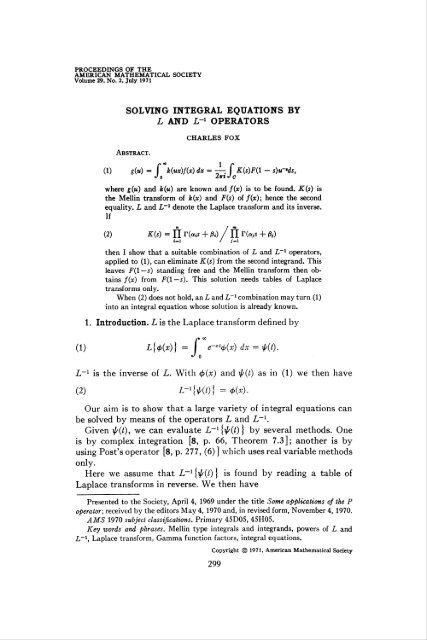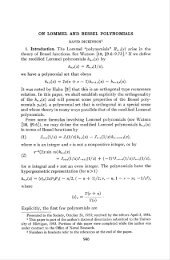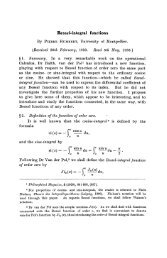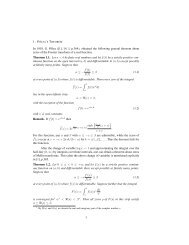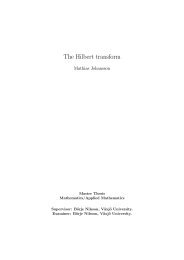C. Fox Solving integral equations by L and L(-1 ... - Fuchs-braun.com
C. Fox Solving integral equations by L and L(-1 ... - Fuchs-braun.com
C. Fox Solving integral equations by L and L(-1 ... - Fuchs-braun.com
Create successful ePaper yourself
Turn your PDF publications into a flip-book with our unique Google optimized e-Paper software.
PROCEEDINGS OF THEAMERICAN MATHEMATICAL SOCIETYVolume 29, No. 2, July 1971SOLVING INTEGRAL EQUATIONS BYL AND L-1 OPERATORSAbstract.CHARLES FOX(1) «G») = f "k(ux)f(x) dx = ^-.{ K(s)F(l - s)u--ds,J o2irt J owhere g{u) <strong>and</strong> k(u) are known <strong>and</strong> f{x) is to be found. K(s) isthe Mellin transform of k (x) <strong>and</strong> F(s) of /(*) ; hence the secondequality. L <strong>and</strong> Z,-1 denote the Laplace transform <strong>and</strong> its inverse.If(2) k(s) = n r(atf + ft) / ft r(a,s + ft)then I show that a suitable <strong>com</strong>bination of L <strong>and</strong> Z,-1 operators,applied to (1), can eliminate K(s) from the second integr<strong>and</strong>. Thisleaves F(l— s) st<strong>and</strong>ing free <strong>and</strong> the Mellin transform then obtainsf(x) from F(l—s). This solution needs tables of Laplacetransforms only.When (2) does not hold, an L <strong>and</strong> Z,-1 <strong>com</strong>bination may turn (1)into an <strong>integral</strong> equation whose solution is already known.1. Introduction. L is the Laplace transform defined <strong>by</strong>(1)/■ oo e-xt(x) dx = $(t).nL"1 is the inverse of L. With cf>(x) <strong>and</strong> ip(t) as in (1) we then have(2) £-M#(0} = *(*).Our aim is to show that a large variety of <strong>integral</strong> <strong>equations</strong> canbe solved <strong>by</strong> means of the operators L <strong>and</strong> L~l.Given ^(t), we can evaluate L~l{ip(t)] <strong>by</strong> several methods. Oneis <strong>by</strong> <strong>com</strong>plex integration [8, p. 66, Theorem 7.3]; another is <strong>by</strong>using Post's operator [8, p. 277, (6) ] which uses real variable methodsonly.Here we assume that L~l{^/(t)] is found <strong>by</strong> reading a table ofLaplace transforms in reverse. We then havePresented to the Society, April 4, 1969 under the title Some applications of the Poperator; received <strong>by</strong> the editors May 4, 1970 <strong>and</strong>, in revised form, November 4, 1970.AMS 1970 subject classifications. Primary 45D05, 45H05.Key words <strong>and</strong> phrases. Mellin type <strong>integral</strong>s <strong>and</strong> integr<strong>and</strong>s, powers of L <strong>and</strong>Z,-1, Laplace transform, Gamma function factors, <strong>integral</strong> <strong>equations</strong>.Copyright © 1971, American Mathematical299Society
300 CHARLES FOX [July(3) Z->[L {*(*)}] = d>(x).2. The annihilating power of L~l. Our basic result is as follows :Theorem. If(i) a>0, ¿a-|-|S>0, i>0;(ii) s = a A-ip, a <strong>and</strong> pboth real; F(s)EL(\—i, \-\- i)then(4) Z,-1 {—; f T(as + ß)F(s)r°'-i>ds\ = — f Fis)ar**-lds,\2iriJc ) 2iriJcwhere, for both <strong>integral</strong>s, the contour C may be the line a = \, a lineparallel to the imaginary axis in the <strong>com</strong>plex s plane.Proof. Let R denote the right-h<strong>and</strong> side of (4). When C is theline 0 <strong>and</strong> F(s)EL(% — i, %-\-i) that the5-<strong>integral</strong> in R, with the factor x^_1 excluded, is absolutely convergentfor all values of x.Let C be the line a = \ <strong>and</strong> consider(5) L\r\ = f e~zt {- \ F(s)xa'+»~ids\ dx.Jo \2iriJ c )The modulus of the integr<strong>and</strong> is e~xi\ F(s)|xa/s+ff_1. Hence, from theconditions, the right-h<strong>and</strong> side of (5) is an absolutely convergentdouble <strong>integral</strong>. Consequently we may change the order of integration<strong>and</strong> integrate first with respect to x. This gives us(6) L{R] = —: I T(as + ß)F(s)r°«-i>ds.2iriJ cFrom equation (3), <strong>and</strong> the remark prior to it, an application of L~lto both sides of (6) gives us(7) R = ¿-1 |—; r r(as + ß)Fis)t-—tds\ ,where Ccan be the line o = \. This <strong>com</strong>pletes the proof of (4).3. Some corollaries of (4). s-<strong>integral</strong>s <strong>and</strong> integr<strong>and</strong>s, as in (4),will be called Mellin type <strong>integral</strong>s <strong>and</strong> Mellin type integr<strong>and</strong>s.(i) (4) shows that when L~l acts on a Mellin type <strong>integral</strong> it caneliminate the factor Y(as-\-ß) from the numerator of the integr<strong>and</strong>.(ii) In (4) write F(s) =H(s)/T(asA-ß) <strong>and</strong> cancel out the <strong>com</strong>monfactor T(as-\-ß) in the left-h<strong>and</strong> side. We then see that when L~l
1971] SOLVING INTEGRAL EQUATIONS BY L AND 2>i OPERATORS 301acts on a Mellin type <strong>integral</strong> it can introduce a new factor r(as+|3)in the denominator of the integr<strong>and</strong>.(iii) R denotes the right-h<strong>and</strong> side of (4). Hence (6) shows thatwhen L acts on a Mellin type <strong>integral</strong> it can introduce a new factorT(as+ß) into the numerator of the integr<strong>and</strong>.(iv) Write F(s) = H(s)/T(as+ß) in (6) <strong>and</strong> cancel out the <strong>com</strong>monfactor r(a5+j3) on the right-h<strong>and</strong> side. Then we can see that L actingon a Mellin type <strong>integral</strong> can eliminate T(as+ß) from the denominatorof the integr<strong>and</strong>.In the special case when a = 1 <strong>and</strong> ß = 0, (iv) is given in [l, p. 132,transform (29)].The eliminating powers of L <strong>and</strong> L~l in (i) <strong>and</strong> (iv) enable us tosolve a wide variety of <strong>integral</strong> <strong>equations</strong>.4. The Mellin transform. In some of our applications we shall needthe Mellin transform <strong>and</strong> some related theory. Iff(x)x>-Hx/» 0 00then we say that F(s) is the Mellin transform of/(x).If (8) holds, then the inverse Mellin transform is given <strong>by</strong>(9) /(*) = — f F(s)x-'ds,where s is a <strong>com</strong>plex variable <strong>and</strong> C is some suitable contour.If F(s) <strong>and</strong> G(s) are, respectively, the Mellin transforms of f(x)<strong>and</strong> g(x) then we also have(10) f /(*)*(*) dx = — f F(s)G(l - s) ds,J 02-ki J csometimes known as the Parseval theorem for Mellin transforms.Conditions <strong>and</strong> proofs for (8), (9), <strong>and</strong> (10) can be found in [4,p. 46, §1.29, p. 60, §2.7 <strong>and</strong> p. 94, §3.17].5. <strong>Solving</strong> <strong>integral</strong> <strong>equations</strong> <strong>by</strong> means of the L <strong>and</strong> L_1 operators.Consider the <strong>integral</strong> equation/2\i/2r>«(11) g(w) = I—) I sin(ux)f(x) dx,where g(u) is known <strong>and</strong> f(x) is to be found.For this example we must first express the <strong>integral</strong> in (11) in theform of a Mellin type <strong>integral</strong> <strong>and</strong> this can be done <strong>by</strong> using the
302 CHARLES FOX [JulyParseval theorem (10). The application of (10) is justified <strong>by</strong> [4, p.60, Theorem 43] with k = %, if f(x) <strong>and</strong> /(x)x~1/2 both belong toi(0, °°) <strong>and</strong> F(s), the Mellin transform of f(x), belongs toP(A—joo, 5-H00). The last condition will also allow us to use thetheorem in §2.The Mellin transform of sin x is given <strong>by</strong> [4, p. 196, (7.9.3)] withv = \, <strong>and</strong> for sin(wx) we must multiply <strong>by</strong> u~'. Hence, the applicationof (10) to (11) gives us(12) g(u) = -^ f 2->/2 *3* + \S) P(l - s)u-ds,2-kiJ c r(i — %s)where, since we can take k = \ in Theorem 43, we may also take C tobe the line
1971] SOLVING INTEGRAL EQUATIONS BY L AND £-1 OPERATORS 303To illustrate (17) let g(u) =0 when 0
304 CHARLES FOX [Julyapply the Parseval theorem (10) to the right-h<strong>and</strong> side of (24) <strong>and</strong>obtain(25) git) = — f 2«+-*r(|i)r(§i + *)F(1 - s)t-'ds,where Fis) is the Mellin transform of fix). If we may use (4) thenL^lgit112)} eliminates TQs) from (25) <strong>and</strong> then, after writingx = 1/i, L-ltr"-1 eliminates r(|s+v). The final result is(26) L-i[t—i{[L-i\gitV2)}Ullt\] = 2—f— f Fií - s)i2x^2)-^ds,¿in J c(27) = 2^Ix'-1'2/(2x1'2),where, in (26), 5 is replaced <strong>by</strong> 1—s <strong>and</strong> then (9) is used to obtain(27), as in going from (16) to (17). (27) is then our solution of (24).If. e.g., git) = 1 /(i2+a2) then, from [l, p. 229, (1)], we haveL-1{git1'2)}=expi-a2x) <strong>and</strong> from [l, p. 245, (40)],(28) L-^t-'-'e-'2"} = a-'xr'Vtfax1!*).From (27), for this choice of git), our solution of (24) is(29) fix) = a~'x1-'J,iax).This solution is easily checked from the K, tables [2, p. 137, (16)]with v= —p, noting that the tables have («i)I/2 in the integr<strong>and</strong> of(24) instead of (mí)' as we have.7. Some general remarks. Suppose that we have the <strong>integral</strong>equationoÄ(«x)/(x) dx,where g{u) <strong>and</strong> kiux) are given <strong>and</strong>/(x) is to be found. On applyingthe Parseval theorem for Mellin transforms (10) to the right-h<strong>and</strong>side of (30) we find that instead of having one Gamma function inthe numerator <strong>and</strong> one in the denominator, as in (12), we haven?=i r(a¿s-f-/3i) in the numerator <strong>and</strong> H x TiajS+ßs) in thedenominator. Then we can proceed as follows:(i) <strong>by</strong> means of an m succession of L operators we can eliminate allthe Gamma functions from the denominator, as in the eliminationfrom (12) to (13) <strong>and</strong>(ii) <strong>by</strong> means of an n succession of L~x operators we can eliminate allthe Gamma functions from the numerator, as in going from (25) to(26).
i97i] SOLVING INTEGRAL EQUATIONS BY L AND £-> OPERATORS 305If convergence conditions allow all these operations to be performedwe shall then have F(\—s) st<strong>and</strong>ing free, as in (26). SinceF(s) is the Mellin transform of f(x) we can then express the final<strong>integral</strong> obtained in terms of f(x), as in going from (26) to (27), <strong>and</strong>so obtain the solution of (30). This method enables us to solve a largevariety of <strong>integral</strong> <strong>equations</strong> <strong>by</strong> using tables of Laplace transformsonly.In the next section we give another useful method of solving<strong>integral</strong> <strong>equations</strong> <strong>by</strong> using the L <strong>and</strong> L~l operators.8. The reduction of an <strong>integral</strong> equation to one whose solution isknown. We illustrate the method <strong>by</strong> means of an example. Considerthe Stieltjes <strong>integral</strong> equation(u + I)-f(u) du, a>0,/►o00where g(t) is given <strong>and</strong>/(w) is to be found. By applying the operatorL to both sides <strong>and</strong> using (1), it is easy to establish thatL~l {(u+t)~a] =xa~le~ux/Y(a). Hence, if we may interchange theorder of applying L"1 to the right-h<strong>and</strong> side of (31) <strong>and</strong> infinite integration,we have(32) L->{g(t)] =-— e-"xf(u)duT(a) J o(31) is then reduced to an <strong>integral</strong> equation which can be solved <strong>by</strong>st<strong>and</strong>ard methods, since (32) can be solved <strong>by</strong> an application of L-1.We now apply L~l to (32), using (2), <strong>and</strong> obtain(33) L-i{r(a)fi-«([L-i{g(t)] L.»,)} = f(x)as our solution of (31).In order to test (33) take a= 1 <strong>and</strong>(34) g(t) = a-'iH'^KrWH1'2), a > 0,where Kv(x) is the associated Bessel function, as in §6 <strong>and</strong>, for convergence— 10 <strong>and</strong> — lO
306 CHARLES FOXStudies of (31), from a point of view quite different from that givenhere, are found in Widder [8, Chapter VIIl], Erdélyi [3], <strong>and</strong> in[2, p. 237, Í33)] a general solution of (31) is given with g(í) <strong>and</strong>/(ii)both expressed as hypergeometric functions.The reduction of (31) to an <strong>integral</strong> equation whose solution canbe obtained <strong>by</strong> known methods requires an application of L~l. Ageneral application of this method will usually require a <strong>com</strong>binationof L <strong>and</strong> L~l operators to make a successful reduction of this nature.9. Some further general remarks. In §3 we have shown that L <strong>and</strong>L~l, when acting upon Mellin type <strong>integral</strong>s, have the power toannihilate or to introduce Gamma function factors into the integr<strong>and</strong>.Here we have only used the annihilating powers of L <strong>and</strong> L~l.But the power of introducing new Gamma function factors is alsouseful <strong>and</strong> leads to many interesting results. For example this powercan be used to show that (17) <strong>and</strong> (21), the two solutions of (11),although apparently quite different from each other are in factidentical.References1. Tables of <strong>integral</strong> transforms. Vol. 1, McGraw-Hill, New York, 1954.2. Tables of <strong>integral</strong> transforms. Vol. 2, McGraw-Hill, New York, 1954.3. A. Erdélyi, On some functional transformations, Univ. e Politécnico Torino.Rend. Sem. Mat. 10 (1951), 217-234. MR 13, 937.4. E. C. Titchmarsh, Theory of Fourier <strong>integral</strong>s, Clarendon Press, Oxford, 1937.5. F. Tri<strong>com</strong>i, Sulla transformazione e il teorem di reciprocita de Hankel, AttiAccad. Naz. Lincei. Rend. Cl. Sei. Fis. Mat. Nat. (6) 22 (1935), 564-571.6. G. N. Watson, Theory of Bessel functions, Cambridge Univ. Press, New York,1922.7. E. T. Whittaker <strong>and</strong> G. N. Watson, Modern analysis, Cambridge Univ. Press,New York, 1915.8. D. V. Widder, The Laplace transform, Princeton Math. Series, vol. 6, PrincetonUniv. Press, Princeton, N. J., 1941. MR 3, 232.Sir George Williams University, Montreal 107, Canada


